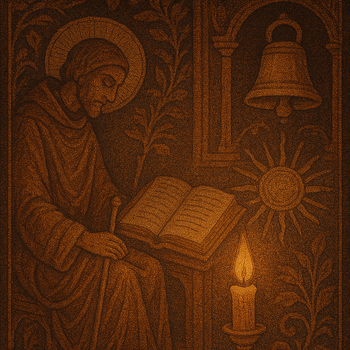Receive God's Love, Proclaim the Greatness of the Lord, Serve Joyfully & Make Missionary Disciples of Jesus Christ
Search
-
 When we speak of the term liturgy we are generally referring to one of two options- Mass which we are very familiar with. We have sacramental celebrations connected directly to the celebration of Mass like weddings, baptism, anointing of the sick, etc… These can also be performed outside of Mass but they still retain most of the structure as if they were during Mass. The other is the Divine Office, which we generally are much less familiar with. The Divine Office is a systematic collection of prayers (especially recitation of psalms) that span different parts of the day.
When we speak of the term liturgy we are generally referring to one of two options- Mass which we are very familiar with. We have sacramental celebrations connected directly to the celebration of Mass like weddings, baptism, anointing of the sick, etc… These can also be performed outside of Mass but they still retain most of the structure as if they were during Mass. The other is the Divine Office, which we generally are much less familiar with. The Divine Office is a systematic collection of prayers (especially recitation of psalms) that span different parts of the day.
In the post-Vatican II church, we are most familiar with morning prayers and evening prayers(both parts of the Divine Office), which are obligatory for clergy to pray each day. These prayers and readings are an additional way to dedicate the day to the Lord and living a Christian life daily. In the coming weeks we will look deeper at the structure of these liturgies and the prayers that are included.
However the Divine Office is actually a collection of nine liturgies spread throughout the day with each having a historical name, structure, and content. However the praying of all nine hours is more reserved for those living in ordered and cloistered communities. The monks and nuns who live in community organize their lives around these nine hours (though each community adapts them a bit). Historically (and today) the praying of these hours was the primary purpose for these orders. In a sense as Catholics our Divine Office brings into the world ceaseless prayer across the globe. We blanket the world in a powerful way with prayer.
While we will dig into the details of the liturgy later it is worth noting that typically over the span of two weeks the divine office includes recitation of all 150 of the psalms in their entirety. Psalms and the depth of human experience expressed in them make the bulk of the Divine Office, melding our prayers across millennia.
The USCCB is currently in the process of finalizing a new English translation of the Divine Office and will be sharing it within the next couple of years. My sincere hope is that more familiarity with the Divine Office may provide another tool (and one strongly encouraged by the church) for use in your personal devotion, and for us to consider more opportunities to pray these as a parish.
RINCÓN DE LITURGIA
El Oficio Divino + La Liturgia de las Horas
Cuando hablamos del término liturgia generalmente nos referimos a una de dos opciones:Masa con las que estamos muy familiarizados. Tenemos celebraciones sacramentales conectadas directamente con la celebración de la Misa, como bodas, bautismos, unción de enfermos, etc. Estas también pueden realizarse fuera de la Misa, pero aún conservan la mayor parte de la estructura como si fueran durante la Misa. La otra es el Oficio Divino, con el que generalmente estamos mucho menos familiarizados. El Oficio Divino es una colección sistemática de oraciones (especialmente la recitación de los salmos) que abarcan diferentes momentos del día.
En la Iglesia post-Vaticano II, estamos más familiarizados con las oraciones de la mañana y de la tarde (ambas partes del Oficio Divino), que son obligatorias para el clero cada día. Estas oraciones y lecturas son una forma adicional de dedicar el día al Señor y de vivir una vida cristiana a diario. En las próximas semanas profundizaremos en la estructura de estas liturgias y las oraciones que las componen.
Sin embargo, el Oficio Divino es en realidad un conjunto de nueve liturgias repartidas a lo largo del día, cada una con un nombre, una estructura y un contenido históricos. Sin embargo, el rezo de las nueve horas está más reservado para quienes viven en comunidades ordenadas y de clausura. Los monjes y monjas que viven en comunidad organizan sus vidas en torno a estas nueve horas (aunque cada comunidad las adapta un poco). Históricamente (y hoy), el rezo de estas horas fue el propósito principal de estas órdenes. En cierto sentido, como católicos, nuestro Oficio Divino trae al mundo la oración incesante por todo el planeta. Inundamos el mundo con nuestra oración de una manera poderosa.
Aunque profundizaremos en los detalles de la liturgia más adelante, cabe destacar que, por lo general, durante dos semanas, el Oficio Divino incluye la recitación completa de los 150 salmos. Los salmos y la profunda experiencia humana que se expresa en ellos constituyen la mayor parte del Oficio Divino, uniendo nuestras oraciones a lo largo de milenios.
La USCCB está finalizando una nueva traducción al inglés del Oficio Divino y la publicará en los próximos dos años. Espero sinceramente que una mayor familiaridad con el Oficio Divino les brinde una herramienta más (muy recomendada por la Iglesia) para su devoción personal, y que consideremos más oportunidades para rezarlo como parroquia.
